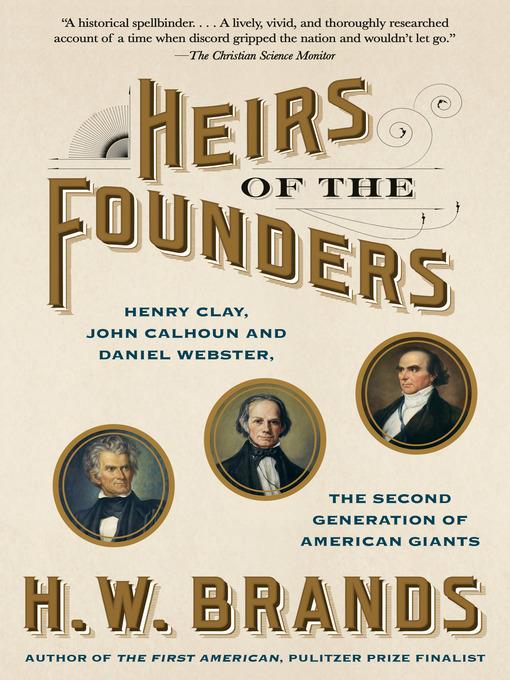
Heirs of the Founders
The Epic Rivalry of Henry Clay, John Calhoun and Daniel Webster, the Second Generation of American Giants
- اطلاعات
- نقد و بررسی
- دیدگاه کاربران
نقد و بررسی

June 15, 2018
Two-time Pulitzer Prize finalist Brand looks at three leaders who took over from the Founding Fathers--eloquent Daniel Webster of Massachusetts, westward-looking Henry Clay of Kentucky, and South Carolina's John Calhoun. The big problems they argued about: the Constitution's ambivalence regarding the ultimate source of authority, the state or the nation, and the blatant contradiction between the country's professed ideals and slavery.
Copyright 2018 Library Journal, LLC Used with permission.

August 1, 2018
Prolific historian Brands (Chair, History/Univ. of Texas; The General vs. the President: MacArthur and Truman at the Brink of Nuclear War, 2016, etc.) continues his project of retelling the American national story through its principal actors.The author's return to the "great man" school of history is somewhat problematic, since those presumed great men of American history are mostly white and seldom women. Still, the approach has virtues in making for a neat, character-driven history of the sort that nonspecialist readers like to read, in the manner of Douglas Brinkley, Steven Ambrose, and other popularizers. Brands goes a little farther afield to deal with three contemporaries who were rivals and occasional allies in the business of deciding what America was going to become at the time when the Founding Fathers were leaving the political field. Daniel Webster, by the author's account, was a mesmerizing orator and debater, a man who "had a way with words that seemed almost supernatural." John Calhoun of South Carolina was almost as gifted as his Massachusetts peer, with a fiery devotion to his home state, while plain-spun Henry Clay of Kentucky had his eyes on the opening West. None of the "great triumvirate," as they were known, lived long enough to reckon with the Civil War and its aftermath, but all were principal players in the great post-Jacksonian debate over slavery and states' rights. The greatest contribution of this book, full of historical set pieces and debates, is the author's parsing of the regional and sectional differences that would lead to conflict, with the South enjoying undue influence. "The South," writes Brands, "acting through the national government, had repeatedly secured the admission of new slave states: nine since the ratification of the Constitution, with Texas likely to spawn more." Given the sectional and ideological divides at work today, the book is oddly timely--and unlikely in the moments when the three politicians managed to forge compromises.A lesser work from Brands but a solid introduction to a post-revolutionary generation whose members, great and small, are little remembered today.
COPYRIGHT(2018) Kirkus Reviews, ALL RIGHTS RESERVED.

September 24, 2018
Brands (The General vs. the President: MacArthur and Truman at the Brink of Nuclear War), a University of Texas at Austin history professor, uses the life stories of three consequential early-19th-century American politicians—all with unfulfilled aspirations to become president—to show how tensions inherent in the founding fathers’ vision of the country led to the calamity of the Civil War. Those schisms played out most notably in the debate about whether new states entering the union, or new territories acquired by annexation or purchase, would be allowed to legislate on their own about the issue of slavery. Each of Brands’s three leads, who competed against each other for the presidency, was tested by slavery. Clay (1777–1852), who served as house speaker and John Quincy Adams’s secretary of state, successfully proposed the Missouri Compromise, linking the admission of that slave state to the admission of Maine, a free state. Webster (1782–1852), a senator and secretary of state to three presidents, abandoned core antislavery principles to advance his prospects for the presidency. And Calhoun (1782–1850), the South Carolinian who was vice president to both Quincy Adams and Andrew Jackson, responded to calls for abolition by doubling down, insisting that slavery was “a positive good, an ornament of the South’s superior culture.” Requiring of readers no prior knowledge of the period or the players, this fascinating history illuminates rifts that still plague the country today.

October 15, 2018
In the decades preceding the Civil War, Congress rather than the executive branch was often in ascendancy, and Henry Clay, John Calhoun, and Daniel Webster were probably its most prominent and influential members. They symbolized and embodied the two great schisms that would eventually lead to the Civil War. The first was emerging sectionalism; Brands (The General vs. the President?, 2016) sees Clay as representing the West, Calhoun the South, and Webster the Northeast. The second, of course, was over slavery, specifically the extension of slavery into the trans-Mississippi West. As Brands indicates, these men weren't always consistent or principled. Calhoun, portrayed as rather oily and unlovable, was a strong nationalist, then an ardent proponent of states' rights and a staunch promoter of slavery. Clay, a slaveholder, claimed to dislike the institution but supported its expansion. Webster used his soaring oratory to praise the Union yet flirted with secession during the War of 1812. Brands presents an engrossing and revealing account of personal rivalries that played out on a national scale.(Reprinted with permission of Booklist, copyright 2018, American Library Association.)




دیدگاه کاربران